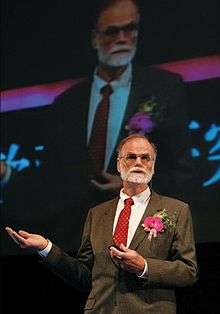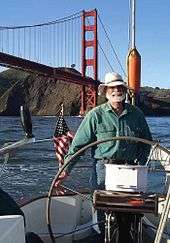Jim Gray (computer scientist)
| Jim Gray | |
|---|---|
 Gray in 2006 | |
| Born |
James Nicholas Gray January 12, 1944[1] San Francisco, California[2] |
| Disappeared |
January 28, 2007 (aged 63) Waters near San Francisco |
| Status | Dead in absentia, May 16, 2012 (aged 68) |
| Nationality | American |
| Alma mater | University of California, Berkeley (Ph.D) |
| Occupation | Computer scientist |
| Employer | |
| Known for | Work on database and transaction processing systems |
| Spouse(s) | Loretta (divorced), Donna Carnes (widowed) |
| Children | 1 (daughter) |
| Awards | Turing Award (1998)[3] |
James Nicholas "Jim" Gray (born January 12, 1944; presumed lost at sea January 28, 2007; declared deceased May 16, 2012[4]) was an American computer scientist who received the Turing Award[5] in 1998 "for seminal contributions to database and transaction processing research and technical leadership in system implementation."
Early years
Gray was born in San Francisco, California, the second child of a mother who was a teacher and a father in the U.S. Army; the family moved to Rome where Gray spent most of the first three years of his life, learning to speak Italian before English.[2] The family then moved to Virginia, spending about four years there, until Gray's parents divorced, after which he returned to San Francisco with his mother.[2] His father, an amateur inventor, patented a design for a ribbon cartridge for typewriters that earned him a substantial royalty stream.[2]
After being turned down for the Air Force Academy he entered the University of California, Berkeley as a freshman in 1961, paying $67 per semester.[2] To help pay for college he worked as a co-op for General Dynamics, where he learned to use a Monroe calculator. Discouraged by his chemistry grades, he left Berkeley for six months, returning after an experience in industry he later described as "dreadful."[2] Gray earned his B.S. in Engineering Mathematics (Math and Statistics) in 1966.[6]
After marrying, Gray moved with his wife Loretta to New Jersey, his wife's home state; she got a job as a teacher and he got one at Bell Labs working on a digital simulation that was to be part of Multics. At Bell, he worked three days a week and spent two days as a Master's student at New York University's Courant Institute. The couple planned to work for a year, making "enough money so that we could take off five years and go travel around the world."[2] Before commencing their travel plans, they returned to Berkeley for three months. After about two months travelling, they returned again to Berkeley, their interest in travelling satisfied.[2] Gray entered graduate school with Michael Harrison as his advisor. Gray got his Ph.D. in 1969, in programming languages, which was followed by two years of post-doctoral work for IBM.[2]
Research
Gray pursued his career primarily working as a researcher and software designer at a number of industrial companies, including IBM, Tandem Computers, and DEC. He joined Microsoft in 1995 and was a Technical Fellow for the company[1][7][8][9][10][11][12][13][14] until he was lost at sea in 2007.[15]
Gray contributed to several major database and transaction processing systems. IBM's System R was the precursor of the SQL relational databases that have become a standard throughout the world. For Microsoft, he worked on TerraServer-USA and Skyserver.
Among his best known achievements are:
- granular database locking[16]
- two-tier transaction commit semantics
- the "five-minute rule" for allocating storage
- the data cube operator for data warehousing applications
- describing the requirements for reliable transaction processing (memorably called the ACID test) and implementing them in software.
He assisted in the development of Virtual Earth.[17][18][19][20] He was also one of the co-founders of the Conference on Innovative Data Systems Research.
Disappearance

On Sunday, January 28, 2007, during a short solo sailing trip to the Farallon Islands near San Francisco to scatter his mother's ashes, Gray and his 40-foot yacht, Tenacious, were reported missing by his wife, Donna Carnes. The Coast Guard searched for four days using a C-130 plane, helicopters, and patrol boats but found no sign of the vessel.[21][22][23][24]
Gray's boat was equipped with an automatically deployable EPIRB (Emergency Position-Indicating Radio Beacon), which should have deployed and begun transmitting the instant his vessel sank. The area around the Farallon Islands where Gray was sailing is well north of the East-West ship channel used by freighters entering and leaving San Francisco Bay. The weather was clear that day and no ships reported striking his boat, nor were any distress radio transmissions reported.
On February 1, 2007, the DigitalGlobe satellite did a scan of the area, generating thousands of images.[25] The images were posted to Amazon Mechanical Turk in order to distribute the work of searching through them, in hopes of spotting his boat.
In the immediate aftermath of the disappearance, many theories were put forward on how Gray disappeared.[26]
On February 16, 2007, the family and friends of Jim Gray Group suspended their search,[27] but continue to follow any important leads. The family ended its underwater search May 31, 2007. Despite much effort and use of high-tech equipment above and below water, searches did not reveal any new clues.[10][28][29][30][31][32]
Having been missing for five years as of May 16, 2012, Gray is legally assumed to have died at sea.[4][33]
Personal life
While at Berkeley, Gray and his first wife Loretta had a daughter; the couple later divorced.[2] He is survived by his wife, Donna Carnes, his daughter, three grandchildren, and his sister Gail.
The University of California, Berkeley and Gray's family hosted a tribute to him on May 31, 2008. The conference included sessions delivered by Richard Rashid and David Vaskevitch.[34] Microsoft's WorldWide Telescope software is dedicated to Gray. In 2008, Microsoft opened a research center in Madison, Wisconsin, named after Jim Gray.[35]
Jim Gray eScience Award
Each year, Microsoft Research presents the Jim Gray eScience Award[36] to a researcher who has made an outstanding contribution to the field of data-intensive computing. Award recipients are selected for their ground-breaking, fundamental contributions to the field of eScience. Previous award winners include Alex Szalay (2007), Carole Goble (2008), Jeff Dozier (2009), Phil Bourne (2010), Mark Abbott (2011), Antony John Williams (2012), and Dr. David Lipman, M.D. (2013).
References
- 1 2 "DeWitt Undergraduate CS Scholarship: Dr. James Gray". University of Wisconsin–Madison. Retrieved 2010-01-18.
- 1 2 3 4 5 6 7 8 9 10 Oral History Interview with Jim Gray ([purl.umn.edu/107339 Synopsis] at Charles Babbage Institute, University of Minnesota. 3 January 2002. Retrieved 2010-01-19.
- ↑ Gray, J. (2003). "What next?: A dozen information-technology research goals" (PDF). Journal of the ACM. 50: 41–57. doi:10.1145/602382.602401. Jim Gray Turing Award lecture
- 1 2 Greengard, Samuel (June 2012). Vardi, Moshe, ed. "Jim Gray Declared Dead". Communications of the ACM. ACM Media. 55 (7): 19. doi:10.1145/2209249.2209257. ISSN 0001-0782.
- ↑ Gray, Jim (1998). "Jim Gray - A.M. Turing Award Winner". ACM.
- ↑ "Biography of Dr. Jim Gray". faircom.com. Retrieved 2 July 2015.
- ↑ Transaction Processing: Concepts and Techniques (with Andreas Reuter) (1993). ISBN 1-55860-190-2.
- ↑ The Benchmark Handbook: For Database and Transaction Processing Systems (1991). Morgan Kaufmann. ISBN 978-1-55860-159-8.
- ↑ Saade, E. (2008). "Search survey for S/V Tenacious" (PDF). ACM SIGMOD Record. 37 (2): 70. doi:10.1145/1379387.1379409.
- 1 2 Hellerstein, J. M.; Tennenhouse, D. L. (2011). "Searching for Jim Gray". Communications of the ACM. 54 (7): 77. doi:10.1145/1965724.1965744.
- ↑ Crawford, D. (2008). "Jim Gray". Communications of the ACM. 51 (11): 7. doi:10.1145/1400214.1400216.
- ↑ Szalay, A. S. (2008). "Jim Gray, astronomer". Communications of the ACM. 51 (11): 58. doi:10.1145/1400214.1400231.
- ↑ Gray, J. (2008). "Technical perspectiveThe Polaris Tableau system". Communications of the ACM. 51 (11): 74. doi:10.1145/1400214.1400233.
- ↑ Stonebraker, M.; Dewitt, D. J. (2008). "A tribute to Jim Gray". Communications of the ACM. 51 (11): 54. doi:10.1145/1400214.1400230.
- ↑ Steve Silberman (24 Jul 2007). "Inside the High Tech Hunt for a Missing Silicon Valley Legend". wired.com. Retrieved 3 Feb 2015.
- ↑ Eswaran, K. P.; Gray, J. N.; Lorie, R. A.; Traiger, I. L. (1976). "The notions of consistency and predicate locks in a database system". Communications of the ACM. 19 (11): 624–633. doi:10.1145/360363.360369.
- ↑ "A Conversation with Jim Gray - ACM Queue". acmqueue.com. Retrieved 2 July 2015.
- ↑ Winslett, Marianne. "Interview with Jim Gray for ACM SIGMOD Record, March 2003 as part of Distinguished Database Profiles" (PDF). sigmod.org.
- ↑ Interview on MSDN Channel 9, Behind the Code, March 3, 2006
- ↑ "Deconstructing databases with Jim Gray". regdeveloper.co.uk.
- ↑ "Coast Guard searches for missing SF boater: 63-year-old man failed to return from trip to Farallon Islands". San Francisco Chronicle. January 29, 2007.
- ↑ Doyle, Jim (January 30, 2007). "Sea search for missing Microsoft scientist: No sign of S.F. man who set out alone for Farallon Islands in 40-foot sailboat". San Francisco Chronicle.
- ↑ Schevitz, Tanya; Rubenstein, Steve (January 31, 2007). "Search for missing sailor extends to Humboldt". San Francisco Chronicle.
- ↑ May, Meredith; Doyle, Jim (January 31, 2007). "Vast search off coast for data wizard". San Francisco Chronicle.
- ↑ Hafner, Katie (February 3, 2007). "Silicon Valley's High-Tech Hunt for Colleague". New York Times. Retrieved May 6, 2010.
- ↑ Doyle, Jim (February 3, 2007). "FARALLON ISLANDS / Missing sailor mystery / Boaters' speculations range from orcas to margarita escape". www.sfgate.com. Retrieved 19 October 2012.
- ↑ "Friends of missing computer scientist suspend search for him". San Francisco Chronicle. February 16, 2007.
- ↑ Inside the High-Tech Hunt for a Missing Silicon Valley Legend, Wired Magazine (August 2007)
- ↑ "Amazon Mechanical Turk - All HITs". mturk.com. Retrieved 2 July 2015.
- ↑ "Tenacious Search". openphi.net. Retrieved 2 July 2015.
- ↑ Help Find Jim Information to help locate Jim Gray
- ↑ Print a MISSING Poster Hang a MISSING Poster in Southern California and Mexico.
- ↑ Wingfield, Nick (May 18, 2012). "Closure in Disappearance of Computer Scientist". The New York Times. Retrieved May 18, 2012.
- ↑ http://www.eecs.berkeley.edu/IPRO/JimGrayTribute
- ↑ http://www.microsoft.com/presspass/features/2008/apr08/04-23DeWitt.mspx
- ↑ "Jim Gray eScience Award - Microsoft Research". microsoft.com. Microsoft. Retrieved 2 July 2015.
External links
- Gray's Microsoft Research home page, last accessed 23 June 2013
- James ("Jim") Nicholas Gray, Turing Award citation
- Video Behind the Code on Channel 9, interviewed by Barbara Fox, 2005
- Video The Future of Software and Databases, expert panel discussion with Rick Cattell, Don Chamberlin, Daniela Florescu, Jim Gray and Jim Melton, Software Development 2002 conference
- Oral History Interview with Jim Gray, Charles Babbage Institute, University of Minnesota. Oral history interview by Philip L. Frana, 3 January 2002, San Francisco, California.
- The Future of Databases, SQL Down Under. Interview with Dr Greg Low, 2005.
- Tribute by Mark Whitehorn for The Register April 30, 2007
- EE380: The Search for Jim Gray, Panel Discussion at Stanford University (video archive) May 28, 2008
(Proceedings) May 31, 2008
- Tribute by James Hamilton
- Why Do Computers Stop and What Can Be Done About It?, a technical report by Jim Gray, 1985